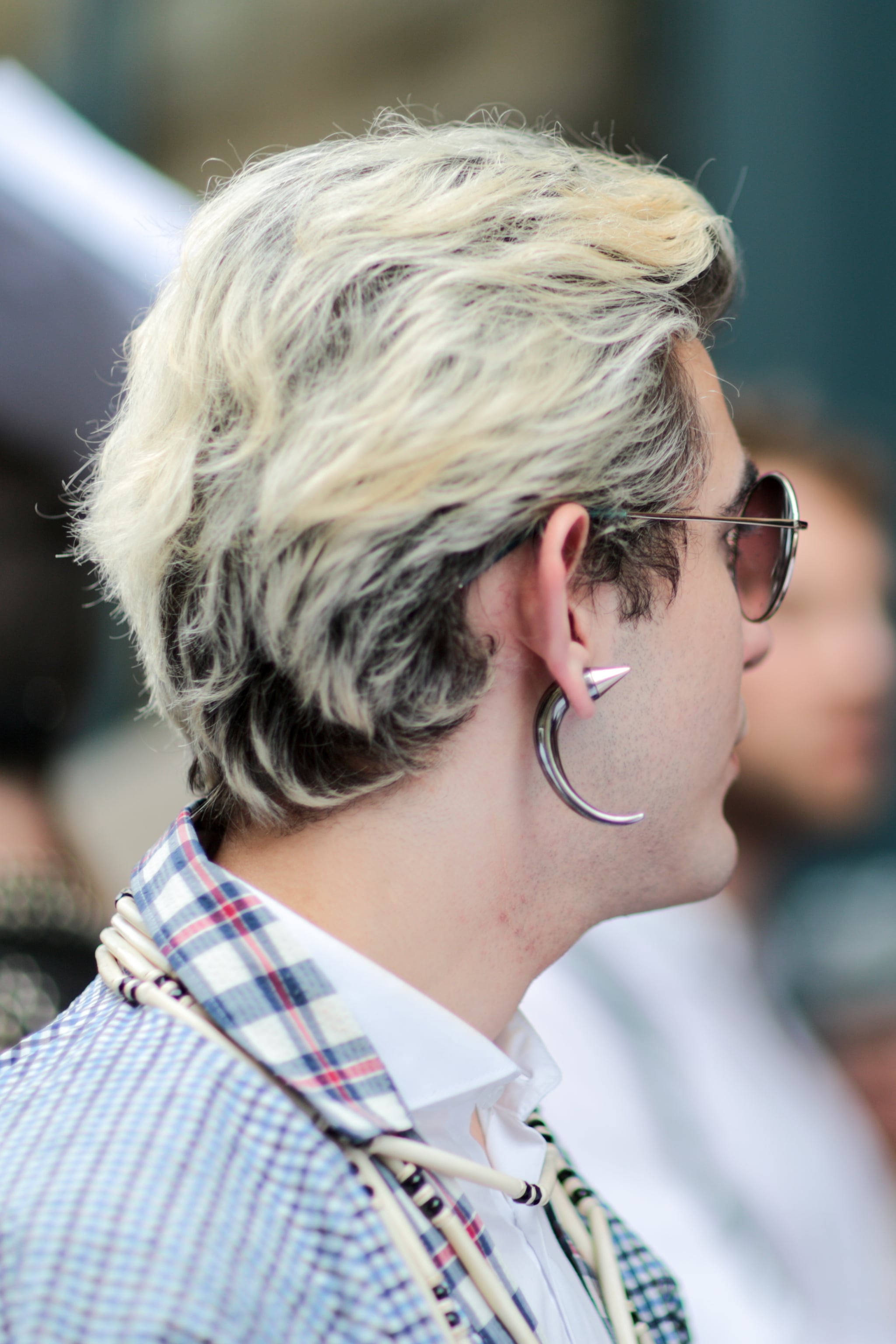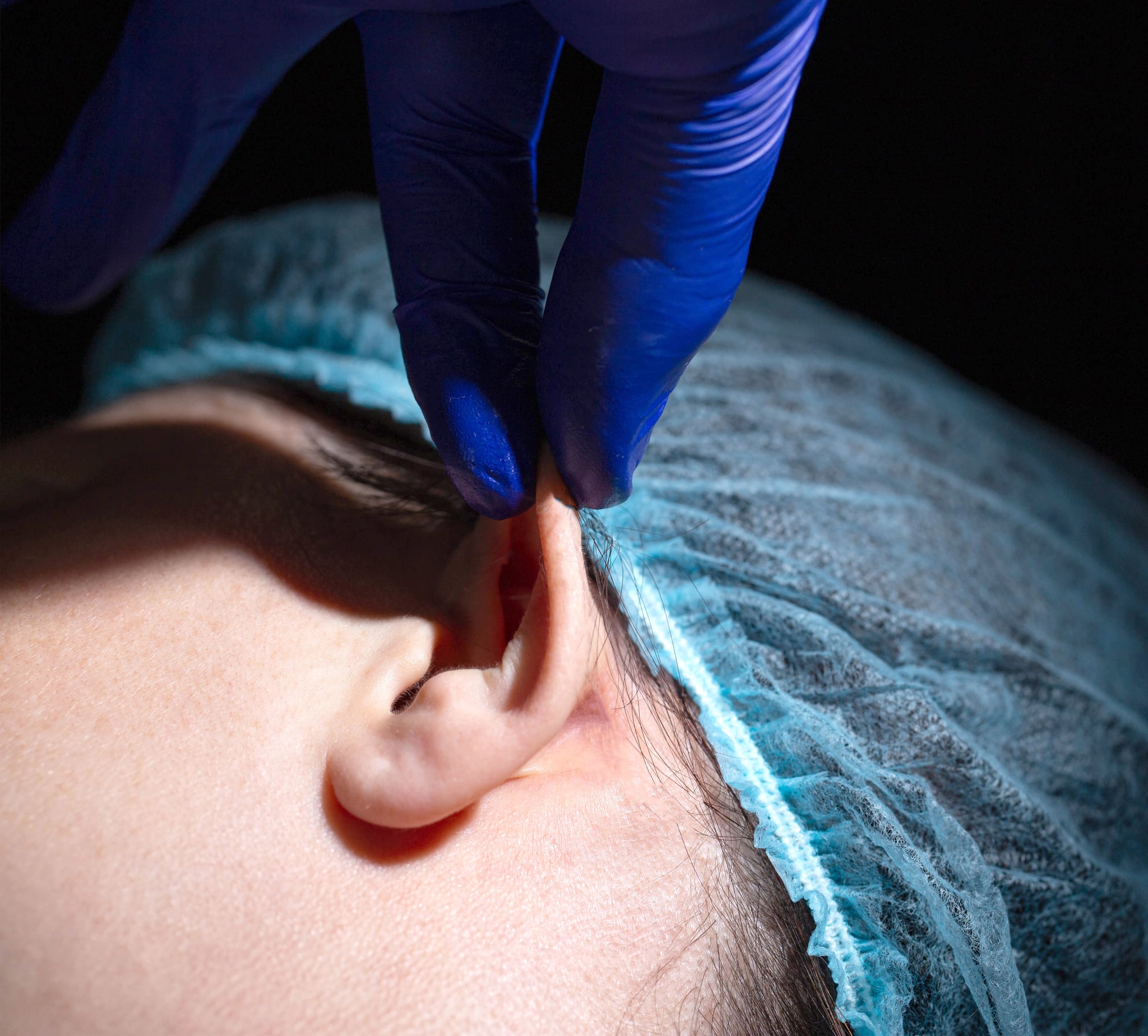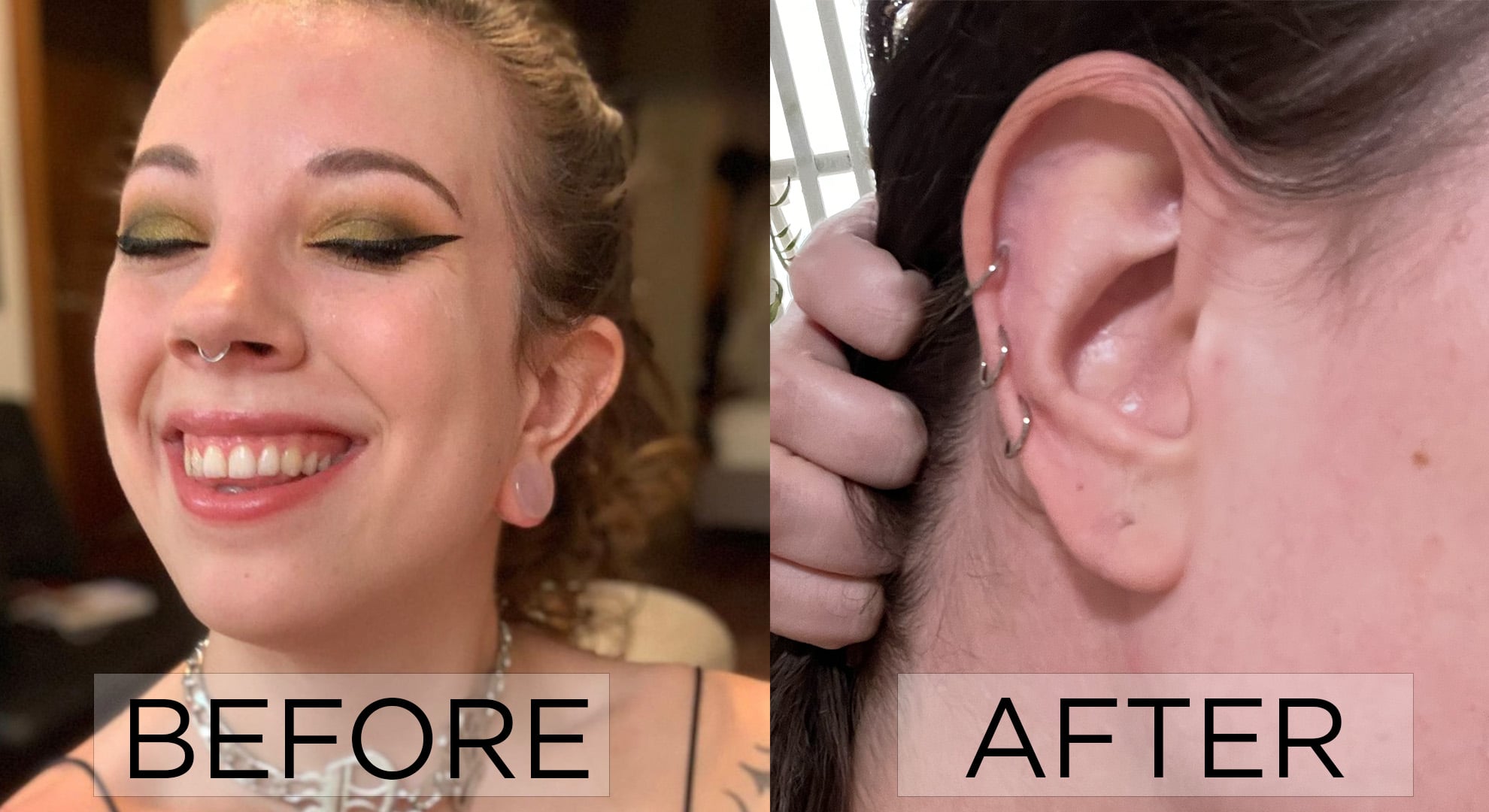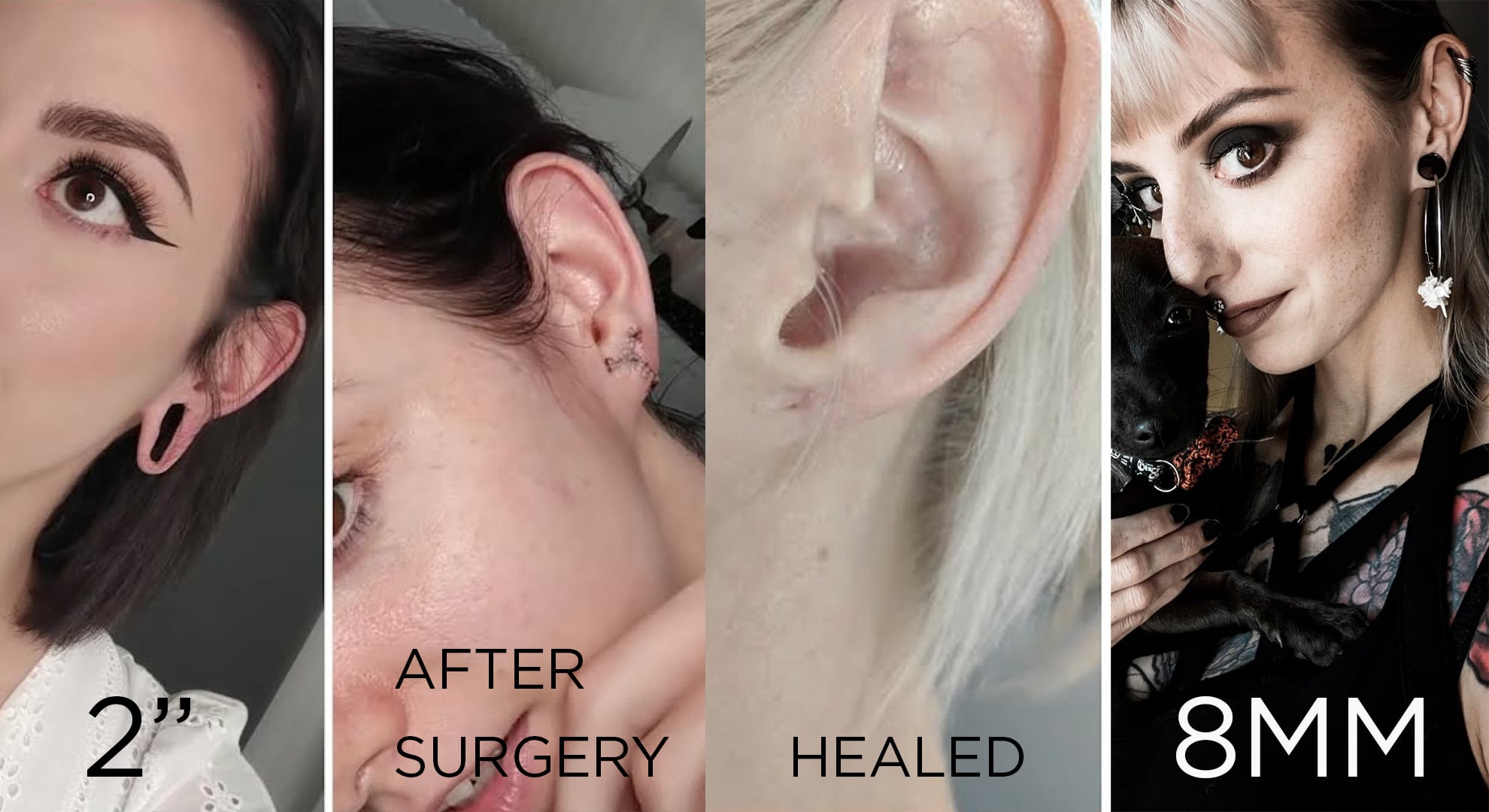Earlobe Reconstruction Surgery: Cost, Pain, and Risks
What to Know About Earlobe Reconstruction Surgery
 Image Source: Getty / Edward Berthelot
Image Source: Getty / Edward Berthelot
There are two things known to be true about body modifications: pain and permanence. They're part of what makes piercings and tattoos so exciting — and yet, the more you look into it, the less painful and permanent they are becoming. If you're scared of the pain, you can ease the burden of a tattoo needle with numbing cream. If you're worried about regretting a tattoo, you can opt for a semi-permanent version that fades in a year or laser away a permanent piece. Similarly, you can always take out a piercing. Having that choice to go back, within reason, can make it easier for people to take a chance on a body modification knowing a reversal is feasible. That's where earlobe reconstruction surgery comes in.
There are plenty of reasons why someone would opt for earlobe surgery. Grimes, for example, reportedly wanted "elf ears." Other, more common, reasons include to correct an elongated earring hole or drooping lobes from wearing heavy earrings for decades or from skin tears after getting an earring caught on something. Or maybe they intentionally stretched their ears and want to go back to a standard earring size.
Stretched ears definitely had their moment over the past two decades. This was partially driven by emo culture of the '00s, with celebrities such as Adam Lambert, Melanie Martinez, and Travis Barker stretching their ears for a period of time. And although stretched ears continue to be very popular, even among Gen-Z crowds who are embracing '00s trends, many who indulged in the trend are looking for a fresh start.
"There are many reasons to get the earlobe repaired," says Jeffrey J. Roth, a board-certified plastic surgeon of Las Vegas Plastic Surgery. "Often earlobe holes will get enlarged from the long-term use of heavy earrings. Or if the earring gets caught (say, on a dress) or pulled (by a child), it can tear the earlobe. People who have [stretched] their ears often need to repair the stretched-out skin."
What is Earlobe Reconstruction Surgery?
"[Earlobe reconstruction surgery] occurs when the earlobe needs to be repaired to improve the form or function of the ear," says Dr. Roth. As stretched ears have become more commonplace, so has the demand for reconstructive surgeries. This is a relatively non-invasive procedure that takes place in a plastic surgery office and can be completed in just a few short hours. Still, given that everyone's earlobe holes are totally unique to each person, plastic surgeons take an individualised approach to reconstructive surgery. If you're working with a small tear or slightly sagging holes from wearing heavy earrings, the surgery can be pretty minimal. "For an earlobe hole that has stretched out, often removing some skin from the earlobe and then closing the hole will do," Dr. Roth says.
When it comes to large and thin lobes that have been stretched extensively, plastic surgeons will need to take a different approach to the procedure. "In other cases, the earlobe has been so stretched out that some of the earlobe must be trimmed and rotated to create a better-looking earlobe," he says.
In doing this procedure, surgeons will go about it in one of two ways: absorbable and non-absorbable sutures. If you get the absorbable sutures, they will typically fall out on their own within a few weeks. Do not try to remove them before they're ready, even if they're feeling slightly itchy. On the other hand, if you get the non-absorbable sutures, then you'll need to go back to your surgeon after a week to have them removed. From there, surgeons may have patients return after a few months in order to evaluate how the incision lines are fading.
 Image Source: Getty / Henadzi Pechan
Image Source: Getty / Henadzi Pechan
How Painful is Earlobe Reconstruction Surgery?
While the surgery itself is painless, as they use local anesthesia during the procedure, you can expect to feel pain in the days thereafter. You'll feel some soreness in your ears, that may radiate toward the back of your head. This varies from person to person depending on your individual pain tolerance, so be prepared.
How Much Does Earlobe Reconstruction Surgery Cost?
"The cost ranges and will range depending on complexity — such as how much time is involved, geographical location and other factors," Dr. Roth says." At my practice, the cost for one ear, with straightforward repair of elongated earlobe hole is $600. The cost for one ear, with complex repair and rotational flaps is $1,200."
What Does the Aftercare Process Look Like?
"The patient should refrain in advance from taking medicines or other things (for instance, alcohol) that could cause bruising or bleeding," Dr. Roth says. "[Once] the procedure is done, the steri-trips are placed and the patient then walks out of the office. We tell them to apply some ice and elevate the head for the next couple of days to decrease swelling."
The recommended aftercare steps may vary, but in any case, you'll want to keep your earlobes clean and dry whenever possible. Similar steps can be taken with earlobe reconstruction surgery and piercing aftercare, such as regularly cleaning the impacted area with clean water and anti-bacterial, unscented soap. If you're cleaning the impacted area, you'll want to be careful of products that may leave particles behind—such as Q-tips, tissues or toilet paper.
Be gentle when cleaning around the impacted area and don't pick at any scabs; let them fall off on their own. In fact, try to avoid touching the incisions at all costs, aside from when cleaning them with clean hands. Avoid submerging your ears in water (such as in the shower or bath) and do your best to avoid getting shampoo, conditioner, face wash, moisturiser or makeup on your earlobes until the initial healing period is complete. Dr. Roth also recommends avoiding smoking, exposure to UV light, as well as aspirin or ibuprofen—which can cause excess bruising. In essence, treat the impacted area like it's an open wound (which it is) and follow the necessary aftercare steps that your surgeon recommends.
Airline or donut pillows can help during the immediate healing process, as you can sleep comfortably without pressure being put on your earlobes. In addition to elevating your head more than normal while you sleep, you won't want to use your good pillowcases, as some bleeding is normal. Some surgeons will recommend lightly wrapping your earlobes in a breathable layer of surgical gauze while you sleep to prevent blood from getting on your pillows or sheets, but you should follow the instructions your surgeon will provide to you. If you're bleeding heavily or in extreme pain after surgery, it's best to contact your plastic surgeon immediately.
Will Ear Reconstruction Surgery Leave a Scar?
One of the great things about this surgery is the human body's ample blood supply in the face, which means any incisions typically heal very well and scars will continue to fade over time. Surgeons can offer a silicone based scar cream that can aid in reducing your scars; however, you can also use vitamin E or jojoba oil after the initial healing process is complete and your incisions have healed over. For instance, if you're healing from earlobe reconstruction surgery, you can use these oils mornings and nights after your incisions had healed. You can apply a small amount of oil to your scars (front and back) and massaged the oil in. Gently massageing your scars promotes blood flow and can improve your scars over time.
 Image Source: Devon Preston
Image Source: Devon Preston
Keep in mind, your scars may appear red and raised in the next few weeks and months following your surgery. This is normal and temporary, as under most circumstances your scars will heal flat and will blend very seamlessly into your earlobes. Plastic surgeons are masters of disguise and are able to transform even the largest of earlobes back to a normal shape. The size and thickness of your lobes will determine the shape your surgeon will be able to create through this procedure. If your earlobes are large and have thinned out considerably, you will be left with small or attached lobes, but those patients are often still able to have their lobes repierced and wear standard earrings.
"Typically, patients are very happy," Roth says. "You can make a very big difference in one office procedure. Earrings will no longer fall through an enlarged hole and if the earlobe has been reconstructed from [stretching], the transformation can be impressive. Most patients afterward say, 'Why didn't I do this earlier?'"
Can You Repierce Your Ears After Reconstruction Surgery?
Some who undergo earlobe reconstruction surgery may choose not to repierce, while others can't wait to wear their favourite earrings once again. However, this is something that you can't immediately jump back into. You'll want to give your earlobes as much time to recover as possible and allow the scar tissue to heal accordingly. Additionally, always opt for a certified piercer when getting a piercing done. You spent time and money on earlobe reconstruction and don't want to fumble the bag at the very end.
"We typically recommend waiting at least three months before re-piercing your ears," Dr. Roth says. "We also recommend piercing at least 3 mm away from the incision line. This is because scar tissue is never as strong as unrepaired tissue."
That's the thing about body modifications — permanence is virtually obsolete. While you may not see yourself ever going back to stretched ears if you have earlobe reconstruction surgery, there's nothing stopping you from going about it a second time if you change your mind. This is a sentiment shared by Alissa Kranjac, also known online as Violet Firehock, a YouTube content creator and tattoo artist, who had her earlobes reconstructed in May 2018. At their largest, her earlobes were two inches. After her surgery, Kranjac spent some time with a standard earring size in her lobes, but then some time later she decided that she wanted to have stretched ears once again. "I've actually stretched them back to 0g," Kranjac says. "I missed them."

Image Source: Alissa Kranjac
How to Find the Best Earlobe Reconstruction Surgeon
There are hundreds of plastic surgeons out there who list earlobe reconstruction as one of their specialties and many of whom show before and after photos, or even reviews from past patients on their website, so be sure to do thorough research before booking an appointment. Once you find your surgeon of choice, you can typically reach out to their office through an online forum or email address. You may be required to do a consultation, in which the surgeon will evaluate how to go about your earlobe reconstruction. In this consultation, your surgeon will be able to examine the thickness, shape and condition of your ears. During this stage, it's also important to notify them if you're prone to keloiding. From there, you can sit back and prepare for your procedure.
So there you have it. You can take your piercings out, you can laser away a tattoo and yes, you can even have your earlobes reconstructed and then go back to stretched ears. Permanence can't come to the phone right now. Why? Because she's dead.






